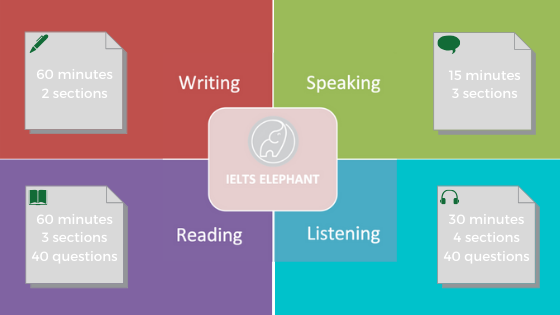IELTS is an important test and succeeding in it can determine your future. In order to prepare well, you need to know what to expect in the test and understand the IELTS test format.
First of all, the IELTS test covers Listening, Reading, Writing and Speaking. Altogether it will take around 3 hours. The first 3 modules come one after another but Speaking will be taken with a live examiner before or shortly after the test. Each section is timed and you cannot go over the given time.
In this article, you’ll learn what is involved in every module. However, I advise you to watch this video to see real IELTS test examples. Dina Panayi, the IELTS Elephant teacher & IELTS examiner explains the test format with real test examples and provides tips on how to approach the test questions.
Before going through the test format, it’s important to clarify that there are two kinds of IELTS tests. If you need to take the IELTS test for studies then you are taking IELTS Academic. If you need to get a visa in the UK or the USA or anywhere where English is the main language then you are taking IELTS General. For more information about the General and Academic Training, read this article.
IELTS Test Format

Listening Test
The IELTS test begins with the Listening test. The Listening test assesses how well you can understand main ideas and information and the opinions of the speakers.
In this part of the test, you will hear a recording of around 30 minutes and you will answer 40 questions in 4 different sections.
In Section 1, there will be a conversation between 2 people in an everyday social context such as opening a bank account, or making enquiries about a trip.
Section 2 is a monologue which means one person is speaking and the subject is also set in a social context such as someone giving an interview or describing changes to a building.
Section 3 is a conversation with up to 4 people in an educational setting. Students may be discussing a class project or requirements for a university course.
Section 4 is a monologue of general academic interest. It’s similar to what you might hear in a university lecture.
In the paper-based test, you’ll have 10 minutes to transfer your answers to the answer sheet. But in the computer-based test, you only have 2 minutes because you write your answers directly on the screen. Find out more about paper and computer-based test in this article.
For a real test example, please watch the video or enrol in the online course to learn the best IELTS techniques. Getting adequate practice is also important so do official practice tests and get lots of extra practice material which are provided with the course in order to achieve a higher IELTS band score.
Reading Test
The questions in the Reading test assess a wide range of reading skills. For example, reading for general meaning and for the main idea and detail. Moreover, you’ll be assessed on your ability to understand an author’s opinion and to follow the development of an argument.
In both Academic and General Reading tests, you have 60 minutes to answer 40 questions. There are 3 different sections. Each section has a passage of around 750 – 800 words which means you have to get through around 2,500 words to find the answers. There are around 10 different question types and each requires specific skills.
The topics in the Academic test are appropriate for candidates entering undergraduate or postgraduate degree courses. They are taken from Academic textbooks or journals but you do not need to have specialist knowledge to answer them. What is required is learning how to find the answer in the text and not being overwhelmed by all the unnecessary detail.
The passages in the General training Reading test are much more visual. They are articles and advertisements from magazines or brochures. These are kind of texts you’re likely to come across in your everyday life.
You can see a Reading test example for both Academic and General Training in this video. To acquire the Reading skills you need to pass IELTS and learn how to answer all question types of the IELTS reading test, check out this course.
Writing Test
You have 60 minutes for the IELTS writing test. It is divided into 2 tasks: Writing Task 1 and Writing Task 2. However, Writing Task 2 is worth twice as much as Writing Task 1 as far as marks are concerned so you should spend more time on it.
Writing Task 1
Once again, there are some differences between Academic and General Training; the main ones are in Writing Task 1.
In Academic Writing Task 1, you are given a graph or diagram of some kind. The most common ones are line graphs, tables, bar charts, tables and pie charts. Watch this video to see diagram examples.
Most of the time you must describe the main changes over the given period of time. The main thing to remember is to summarise the information. That means not putting in unnecessary detail. For the best tips and a sentence-by-sentence guide on how to answer Task 1 questions for each graph, enrol in the course now.
General Writing Task 1 is very different. In this case, you must write a letter which could be informal, such as to a friend, semi-formal such as one you would write to your landlord or formal, such as the kind of letter you would write to your manager or to a university official. Watch this video for test examples.
In both Academic and General Training, you should spend just 20 minutes on Task 1 and write around 150 words. Learning the structure and being prepared for any kind of graph you are given is the key to completing this task in the given time and more importantly accurately so that you can get a high score.
Writing Task 2
In Writing Task 2, you have 40 minutes to write around 250 words.
You must write a formal essay on a general social issue. A social issue means issues you or people you know may come across every day. For example, unemployment, crime, problems of the elderly or problems about the environment or urban problems. This book contains ideas, vocabulary and Task 2 questions for the common IELTS topics to help you answer Task 2 questions fast.
There are different kinds of essays. The most common ones are For and Against, Opinion essays and Problem, Cause and Solution essays.
The main thing to remember is to write an essay which answers the question and gives examples to support your ideas. In addition, your essay should also use language accurately and have a logical structure. A logical structure means having an introduction where you introduce the topic, a main body where you explain the issue or support your opinion and of course a conclusion where you summarise your opinion so the examiner is clear as to what you believe. With this course, you will be guided, sentence-by-sentence on what you need to write to get a higher score. You will learn everything you need so that Task 2 becomes easy for you.
Speaking Test
The Speaking part of the test is a face-to-face interview between you and a certified IELTS Speaking examiner. The examiner conducts the interview and evaluates your performance at the same time. The whole interview takes around 14 minutes, there are 3 parts and each part is strictly timed.
In Part 1, the examiner introduces him/herself and checks your identity. Then, he/she will ask some general questions about you to get to know you such as questions about your home, studies or work.
This part of the test assesses your ability to express your opinion and provide information about a variety of topics.
In Part 2, you will be given a cue card with a topic which you must talk about for 2 minutes. There are 4 bullet points on the card which should be included in the talk. You are given 1 minute to prepare for this topic and some paper and a pencil to make notes so you remember what to say. The second part of the Speaking test, tests your ability to speak at length on a given topic, using appropriate language and organising your ideas coherently.
In Speaking Part 3, the examiner and you will discuss a number of issues related to part 2 in a more general and abstract way and in greater depth. This part analyses the candidate’s ability to justify their opinion, analyse, discuss and speculate about issues.
For a Speaking test example, watch this video. For a guide on how to prepare and approach each part of the test, check out the full IELTS preparation course.
Last notes…
Now you know what to expect in each module of the IELTS test. So, all you need is to learn how to approach each question type so you’re ready to take the IELTS test. The Complete IELTS preparation course will teach you everything you need to know to prepare and succeed in your IELTS goals:
- Best IELTS methods & tips for ALL modules.
- Easy-to-follow lectures.
- Quizzes & Assignments.
- Free book with extra practice material. Lifetime access.
